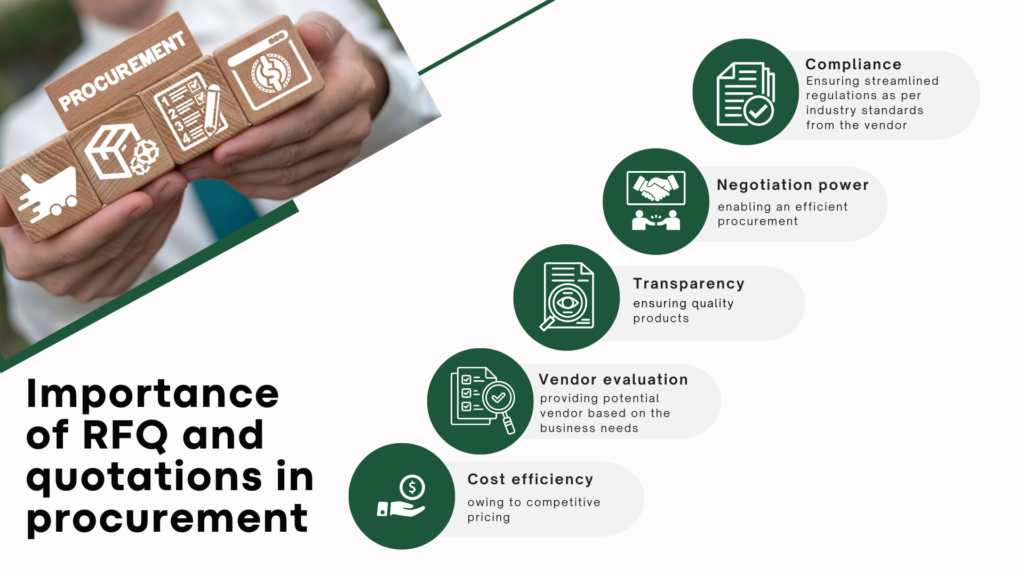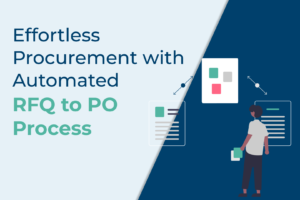However, with ever-changing economic instability and recession, the landscape of procurement has become dynamic. Competitive procurement is proving to be a lifeboat ensuring that the products and services meet the required standards.
These scenarios have brought vendor vetting, analysis of received quotations, and vigilance regarding product specifications and costs into the spotlight, ensuring optimized costs and processes.
What is RFQ?
A Request for Quotation (RFQ) is like a formal document sent to suppliers or vendors, requesting them to share details and prices for specific requirements of a buyer. It helps the buyer compare offers before carrying out the vendor selection process for the requirement.

The standard process of selecting an appropriate vendor
Depending on the requirement, vendors from the Master Vendor List (MLV) are contacted by the procurement teams to send quotations.
The vendors are sent a Request for quotation (RFQ or RFP) in most cases via email. This document consists of some necessary details of the product or service required such as:
- The requirement consisting of an exact production description (Eg: In case of requirement of stainless-steel rods it is necessary to mention the grade, gauge, diameter, and type of the steel rod).
- The exact quantity with units
- Quality specifications
- Payment fine print
- Deliverable details and more, depending on the preference of the customer company.
The vendors on receiving the RFQ, fills the information against the requirements, seek approvals from the concerned authorities of the company, and sends it back to the customer in the form of a reply to the email received from the customer as being the most prevalent way.
The customer then analyzes the quote received from each vendor.
Although it sounds easy, imagine analyzing several quotes for one requirement while dealing with multiple such requirements in a day. Navigating through the intricacies of sending RFQs and receiving a multitude of quotes can be a time-consuming challenge.
Whether it’s for materials, services, or equipment, businesses in all sectors engage in a continual process of seeking, data collation, and evaluating quotations to meet their diverse needs and operational requirements.
Exploring the challenges of manually processing the RFQs:
- Volume overload: Dealing with a high volume of incoming quotations can be overwhelming, as each quotation needs to be analyzed carefully.
- Time-Consuming Manual Review: Manually comparing quotations is tedious, as every field needs to be compared across multiple quotation documents meticulously.
- Inconsistent Formats and Layout: Different suppliers often send quotations in various formats and layouts. Manually comparing each, especially given the inconsistency in layouts, can become challenging and involve resources.
- Delayed processes: In a fast-paced business environment, delays in processing quotations can disrupt the lean management and Just-in-Time(JIT) strategies of the organization, resulting in an imbalance of operational costs. Suppliers, while submitting the quotations, seldom include a validity clause. Delayed processing not only hampers the efficiency of the purchase to pay because of delayed purchase orders but, in many cases, also affects the bottom line.
- Error-prone: Handling quotations manually may result in various errors, potentially leading to significant business losses. These mistakes may include inaccuracies in pricing, overlooked details, or delays in processing, ultimately affecting the financial performance and credibility of the company.
These limitations and challenges of manually collating and processing data from multiple quotations not only wear out the purchase department but also adversely affect the procurement process by:
- Losing precious time in going through the same process on receiving revised quotations post negotiations.
- Causing a delay in getting required approvals for the selected quote.
- Releasing the purchase order to the selected vendor.
The solution to countering these adverse effects is adopting an easy-to-implement automation solution. These solutions not only counter the limitation of manually processing and analyzing the quotes but also enable companies to make well-informed decisions swiftly.
The shift from manual analysis to automated collation is not just a technological upgrade; it is a strategic investment that empowers the procurement teams, ultimately driving improved outcomes and resilience in the procurement process.


